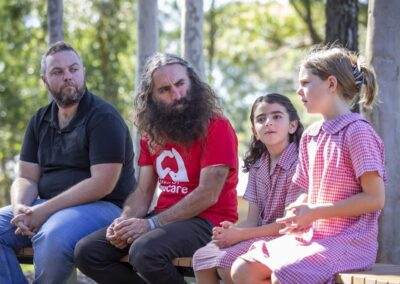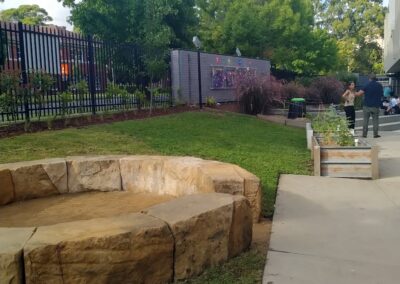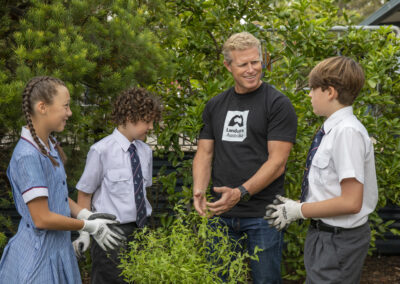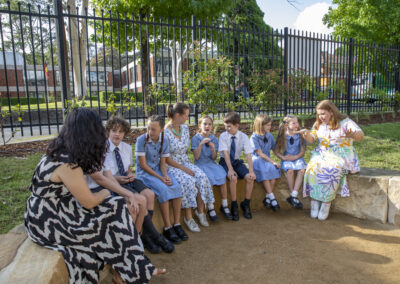LEARNING ACTIVITY
STORY
Mrs Smith and Mrs Collins were meeting to discuss the acquittal paperwork for the grant that funded their yarning circle.
“Now that the circle is in, it would be nice to plant some more bush tucker plants in and around that space to really spruce it up,” said Mrs Collins.
“I might not be the right person here,” said Mrs Smith. “I’m the opposite of a green thumb. A dead thumb?”
“There was that group – the Landcare group – they may be able to help? It would be really nice to be able to use the yarning circle as a feature in the school and do a few more things with the community.”
“We have student leadership time later this week,” said Mrs Smith. “I will get them onto it – at least with some guidance we might have more success than if I try and do it on my own!”

This activity is the fifth activity in an 8-part activity sequence that has been developed to help you design, build and use a yarning circle in your space.
This activity is designed to help you make connections with your local Landcare or environmental group and facilitate a partnership with these organisations.
The order of these learning activities are: background, site selection, involving First Nations people, building the yarning circle, connecting to Landcare, using the yarning circle, yarning circle activities and yarning and wellbeing.
For children to:
- make connections with community organisations
- work with Landcare and environmental groups to enhance their school and local environment
- value the natural features around their school.
This activity can be undertaken at any time of the year.
Introduction
In this activity you are going to connect with your local Landcare or other community environment group. Working with your local Landcare or environment group is a great way to access local expertise, support and resources.
Connecting with Landcare can occur at any time during your yarning circle project, from the initial phase when you are selecting your site to set up your yarning circle to enhancing the area around your yarning circle once it has been established.
Landcare doesn’t always need to be a hands-on activity. Immersing children in a yarn or conversation is a great way to build their understanding and awareness of different cultures, landscapes and why it’s important to care for their environment and our natural resources.
Having a yarning circle in your school is also a great focal point for understanding the intricacies of your local landscape, connection to culture and connection to Country. It provides a space for many tangible and intangible connections that you can draw to enrich learning experiences.
Checklist
Instructions

Step 1
Preparation:
In this activity you will be showcasing your yarning circle to your local Landcare or environmental group.
Use the Find a Group directory on the Landcare Australia website if you do not already know who your local group is and invite them to come to your school. If there is no local Landcare group near to your school, contact other environmental organisations working in your area.
Get in touch with your local First Nations representatives or community members who you have been working with and invite them as well. If you do not have any existing contacts or direct links with First Nations organisations or people in your area, a good starting point is to contact either the Local Aboriginal Land Council (LALC) or Local Aboriginal Education Consultative Group.
Note: this activity can be undertaken at any time during the development of your yarning circle project.

Step 2
Identify needs:
Head outside with your students.
Using the Activity Sheet, identify what is working well in your space and what you could use some assistance with from a group such as Landcare.
Examples include:
- Help sourcing and planting Indigenous plants around the yarning circle
- Identifying the plants and animals in the area around the yarning circle
- Weeding/weed removal.

Step 3
Present:
Begin this activity with an Acknowledgement of Country. By acknowledging the Land, you are also making a promise that you will recognise the cultural practices of First Nations people.
As a team, present to your invited guests.
Explain what you have set out to achieve, what has worked well and what you think you would like some assistance with to enhance your yarning circle and the surrounding area.
Ask for suggestions and thoughts on things you may not have considered.

Step 4
Sharing:
Have a conversation between your students, the Landcare members and/or the First Nations representatives or community members who have come to your school.
Think about:
- How you can work together?
- What assistance/expertise Landcare can provide?
- Other resources you could develop/share?
Extension Activity
Media release: Write a media release for your local newspaper/publication telling them about what you have achieved, learnt and what you are going to do next with your yarning circle.
Curriculum and Framework Links
SCIENCE
Year 5: ACSHE083
Year 7: ACSHE120
Year 8: ACSHE135
HUMANITIES AND SOCIAL SCIENCES
Year 2: ACHASSI042
Year 3: ACHASSI052, ACHASSI059, ACHASSI060
Year 4: ACHASSI080, ACHASSK088, ACHASSK090
Year 5: ACHASSI102, ACHASSK120
Year 6: ACHASSI122, ACHASSI130
DESIGN AND TECHNOLOGIES
Year 2: ACTDEK003
Year 3 & 4: ACTDEP017
Year 5 & 6: ACTDEP019
Year 7 & 8: ACTDEK032
HEALTH AND PHYSICAL EDUCATION
Year 2: ACPPS018, ACPPS022, ACPPS023
Year 3 & 4: ACPPS036, ACPPS040, ACPPS041
Year 5 & 6: ACPPS054, ACPPS059
Year 7 & 8: ACPPS073, ACPPS078
ABORIGINAL AND TORRES STRAIT ISLANDER HISTORIES AND CULTURES
ETHICAL UNDERSTANDING
Exploring values, rights and responsibilities.
PERSONAL AND SOCIAL CAPABILITY
CURRICULUM CONNECTIONS
CROSS CURRICULUM PRIORITY
MY TIME, OUR PLACE: FRAMEWORK FOR SCHOOL AGE CARE
Reference List
ONLINE RESOURCES
Use the Find a Group directory on the Landcare Australia website if you do not already know who your local group is.
PRINTABLE RESOURCES
Download the How to Start a Junior Landcare group at your school or within your local community, or explore the resource here.
WATCH
Fire and Water, Healing Country and People (Landcare Australia).
READ
Discover more about the origins of Landcare and what makes landcare unique to any other community movement.
NETWORK
We recommend reaching out to the Local Traditional owners and First Nations peoples community groups who can assist in knowledge sharing and understanding local land, language, stories and culture.
To reach out or find contacts in your local First Nations community you could speak to parents of First Nations students, to an Indigenous Learning Officer (ILO) at your school or to a local Land council.
We have some suggested organisations to approach listed on our Junior Landcare Community page.
We value your feedback
When you have finished this learning activity, please tell us what you think with our survey.
Your feedback will help Landcare Australia improve the activities in the Junior Landcare Learning Centre.
Why not try one of our other Junior Landcare learning activities?
Creating an Indigenous plant-use garden: plant list
First Nations Perspectives
Creating an Indigenous plant-use garden: resources from the bush
First Nations Perspectives
Love Letters to the Land
Biodiversity|First Nations Perspectives|Food Production|Waste Management
Creating a yarning circle: involving First Nations people
First Nations Perspectives